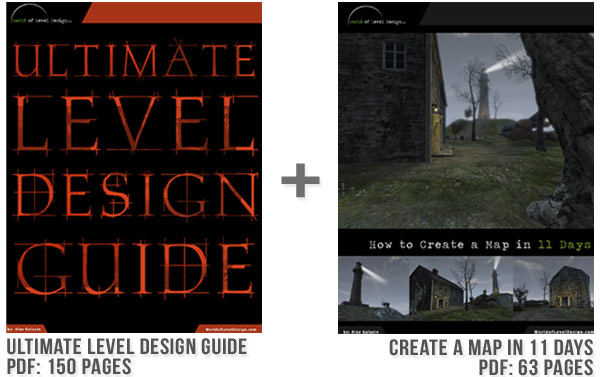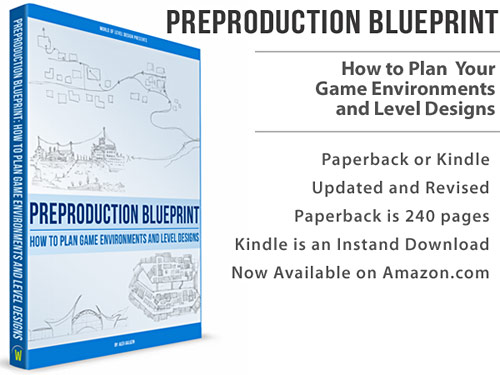World of Level Design™
Tutorials to Becoming the Best Level Designer and Game Environment Artist (since 2008)
Master Class in Level Design Storytelling - 6 Secrets I Learned from Playing "Alan Wake"
Category: Level Design
August 30, 2023

I picked up Alan Wake in the bargain bin at Target over 10 years ago.
I love Max Payne 1 and 2 and wanted to play another game that was crafted by Remedy Games.
At the time I enjoyed Alan Wake just to play.
I recently replayed the game, this time I had a different reason for playing. I wanted to learn how Remedy created the single-player, story driven experience and how this influenced its level design.
I walked away with 12-pages of notes.

Here is what I learned about level design storytelling from playing Alan Wake.
Important Note: Following tutorial (like all tutorials on WoLD) is based on my own experience, opinions and conclusions as I was playing the game. Nothing here reflects what the developer or the publisher might have intended or did not intend as they were creating the game. These are opinions and conclusions I reached.
Spoil Alert: This tutorial features spoilers.
Video Tutorial
Storytelling Secret #1: Use Primary and Secondary Levels
Alan Wake is a single-player, third-person adventure horror with heavy emphasis on storytelling. For such a game, each level design decision has to be filtered through the game's story.
Each level has to reveal parts of story, introducing and continuing specific plot points/beats, locations and characters as the player progresses.
Alan Wake is broken down into two types of levels: primary levels and secondary levels.
- Primary Levels usually reveal major plot points which move the story and the game forward; primary levels include game objectives, obstacles, cinematics, scripted events and heavy emphasis on combat
- Secondary Levels help to build player connection with the game world; secondary levels include visiting and exploring locations, meeting characters, interacting with the locals and learning more about the game's world; it is where you are allowed to explore the location on your own terms without having to fight and survive
Examples of Primary Levels include:going to the Gas Station, Lover's Peak, Mining and Ghost Town, escaping Cauldron Lake Lodge, going to Anderson Farm, going through the Town, Bright Falls Light & Power, Bright Falls Dam and Larsen's Auto Salvage.
Primary Level: going to Gas Station.

Primary Level: Lover's Peak.

Primary Level: Mining and Ghost Town.

Primary Level: Escaping Cauldron Lake.

Primary Level: Anderson's Farm.

Primary Level: Town.

Primary Level: Light and Power.

Primary Level: Dam.

Primary Level: Larsen's Auto Salvage.

Examples of Secondary Levels include: first level on the boat, visiting the Diner to get the cabin keys, vising Bird Leg Cabin with Alice, driving to the mining caves, visiting mobile homes (Sparkling River Estates), NYC flashbacks.
Secondary Level: boat ride.

Secondary Level: Diner.

Secondary Level: Bird Leg Cabin with Alice.

Secondary Level: driving to mining caves.

Secondary Level: visiting mobile home park.

Secondary Level: NYC flashbacks.

The sequence of each level (primary or secondary) should always be determined by the game's story and how you want to communicate that to the player. With primary and secondary levels it allows you to design how you want to the story and the game to unfold and at what pace.
Secret #1 Takeaway: level design decisions have to be filtered through the game's story. To tell the game's story effectively through level design, you have to weave primary and secondary levels through your game.
Storytelling Secret #2: First Level is a Tutorial Blueprint
First level in Alan Wake is a tutorial.

This is common to a lot of games. It introduces the player to the game world, gameplay mechanics and its story. But this first level is more than that. It is a blueprint to learn from.
To create the tutorial level you have to know the game, understand its gameplay mechanics and use level design to create the playable space.
What would you do?
- If you had to design the first tutorial level for your favorite game, what would you do?
- How would you teach the player to play the game?
- What would you create? How would you design the level?
- How would you want the player to start, advance and progress through this first tutorial level?
- What would you leave out?
In Alan Wake's first tutorial level I learned:
- Basic gameplay mechanics of the game.
- The entire theme of the game is guiding you with light; always go towards the light (important level design principle).
- You learn the combat system and how to use light to fight.
- Introduction of landmarks which are focal points in the level that help guide the player. These landmarks are used constantly throughout the game (more on this later).
- How the level designer set up the first combat area without a weapon, then a single enemy and then multiple enemies. Combat level design is fun to create but requires a lot of thought behind it. In a blueprint level like this, there is a natural progression you follow for teaching the player the combat mechanics.
- First arena contains an enemy armed with an ax and you are unarmed - this teaches you how to dodge.
- Second arena gives you light and a weapon - this teaches how to use the light and shoot.
- Third arena introduces multiple enemies, putting everything together.
- You go through few hard gates within the level. These are locations in the map where you jump down and unable to backtrack (more on this later).
- Using F key to focus on what the level designer wants you to pay attention to.
- Introduction of running and avoiding environmental hazards which is repeated throughout the game.
- Introduction of “The Tornado”, which is an important element you experience throughout the game and the final boss.
It's a short level but packs a lot of information on gameplay mechanics, story and level design.
Secret Takeaway: first tutorial levels are very important to the player, not only do they teach you about the game, its story, gameplay mechanics and level design but can also be used as a primer to introduce what to expect for the rest of the game.
Storytelling Secret #3: How to Introduce Characters
You might ask what characters in the game have to do with level design.
Character introduction and their development are dictated by the game's story. But as a level designer you have to create the playable space where these characters are introduced and live. So it is up to you to design the world and arrange the sequence.
Just within the first few minutes of playing, most of the game's characters are introduced. All of them will make re-appearances throughout the game.
In the beginning of the game during the boat ride you are introduced to three characters Ben Mott (local), Pat Maine (radio host) and Barry (Alan Wake's agent) and of course Alan's wife. All of these characters are important to the game.

Next in the Diner, seven more characters are introduced: Rose, Ranger Rusty, Anderson brothers, Cynthia Weaver, Barbara Jagger and Carl Stucky.

No character that is important to the story comes out of blue. They are first introduced in a causal way, usually through a secondary level.
Even at the Sheriff's station, inside the jail cell you meet the guy who you later see in the cabin on your way to Anderson's Farm. That is how you connect your game world together.


Of course you can't introduce every single character in the first few levels, but you can mention them through dialogue, props or cinematics.
Emil Hartman is an important character to the story and is introduced through dialogue from Alice and through a book in Alan's car.

Most of character introductions happen within a forced area such as the boat ride, diner, Sherriff Station, Cauldron Lake to make sure you don't miss it.

Secret Takeaway: introduce as many characters in the beginning as you can in a casual way using a secondary level. Re-introducing them later will make sense because the player already met them. Never have a character that is important to the story come out of nowhere. Reveal the game's story and its characters deliberately.
Storytelling Secret #4: How to Introduce Game's Locations
Locations of the game are introduced to the player in similar way as the characters.
You first visit most of the locations casually, in the safety of daylight. You can explore and talk to the locals. Then you also visit the same locations at night.
Such locations include the Diner:


Elderwood Visitor Center:


Sherriff Station:


Sparkling River Estates:


Cauldron Lake Lodge:


You can explore, learn location's history, meet characters and enjoy the scenery.
Most importantly and probably without realizing, you learn the map's layout since you will be coming back here at night.
The effect would not be the same if you had to visit most of these places at night and for the first time. There wouldn't be a connection made between the player and the game world.
Another advantage is you only have to create these locations once then re-use it with different lighting and gameplay.
Of course not all locations are introduced in the daylight then re-visited at night. There has to be a balance. Many locations are visited only once such Bright Fall Power/Light, Dam, Anderson's Farm, Coal Mines, Ghost Town, Lover's Peak, KBF-FM Radio Station and Larsen's Auto Salvage.
Secret Takeaway: introduce the game's locations first in a casual way through a secondary level. Allow the player to explore and learn the layout. Then re-introduce that location later in the game as a primary level.
Storytelling Secret #5: Level Design Landmarks
One of my favorite techniques used in the game is to show the final destination where the player has to reach at the beginning of the level.
This is used constantly throughout Alan Wake.
It gives you a landmark to orient yourself and it guides where you need to go. This landmark is often seen throughout various parts of the level.
Light House in the tutorial level is seen right from the start and it's where you end up going:

Gas station after the car crash is seen at the start and it's your final destination:

The rail road bridge is shown at the beginning of the level and you end up circling back through the forest and under the bridge:

Anderson's Farm is seen in the beginning and it's where you need to go:

Bright Falls Light and Power is another example:

And so is the Dam location:

Secret Takeaway: design your levels in a way as to show the player final destination at the start of the map. This gives the player a direction to head for and a way to orient themselves within the level so they don't get lost. They will always know where to go.
Storytelling Secret #6: Use Foreshadowing
Foreshadowing is a warning or an indication of a future event. It is a hint of something that will happen.
It's a form of storytelling used in all genres of fiction, movies and games.
In Alan Wake foreshadowing is used with characters, level events, props and upcoming obstacles.
Anytime you interact with a character, they often tell you what you should be aware of.
Such as in the diner at the start of the game. Cynthia Weaver foreshadows the absence of light as something to be afraid of. The mood and atmosphere changes as you walk through the shadowed hallway:

Another foreshadowing example is the history of the Cauldron Lake told by Barry when you are visiting Sparkling River Estates. Cauldron Lake is a place you visit often and come back to at the end of the game:

Anytime you pick up some items, it foreshadows an upcoming event where you'll have to use them. Such as the flares when you have to follow Ben Mott and protect him:

Or when you pick up a set of flashbangs near the car, which you end up using right after:

Introduction of all the characters in the beginning of the game, in the Diner is foreshadowing all of their re-appearances:

Foreshadowing of Cauldron Lake Lodge location in the distance when you first arrive to Bird Leg Cabin with Alice:

Many levels feature a landmark in the distance, foreshadowing the location to where you need to get to as covered in Secret #5.
When you are going through the forest, the atmosphere will often change from calm to sinister, foreshadowing the arrival of Taken:

Some props in the game foreshadow their reappearance later such as DeerFest truck which can be seen from the boat at the beginning of the game. Then at the gas station and later in the game at the Town level:


Emil Hartman's book in the car, foreshadowing an important character in the game that hasn't appeared yet:

Crows are a recurring element throughout the game. They first appear at the Bird Leg Cabin and make additional appearances throughout various parts of the game's levels:

Manuscript pages scattered around the game, foreshadowing upcoming events:

There are many examples of foreshadowing in the game and it is something you should use in your own environments and level designs.
Secret Takeaway: use indications of a future event in your game environments with characters, locations, dialogue and props. Reveal the story, show locations, build tension and create connection with foreshadowing.
Key Takeaways
- Each level has to reveal parts of story, introducing and continuing specific plot points/beats, locations and characters as the player progresses.
- Alan Wake is broken down into primary levels and secondary levels.
- Primary Levels reveal major plot points which move the story and the game forward; includes game objectives, obstacles, cinematics, scripted events and heavy emphasis on combat.
- Secondary Levels help to build player connection with the game world; includes visiting and exploring locations, meeting characters, interacting with the locals and learning more about the game's world.
- The sequence of each level (primary or secondary) should always be determined by the game's story and how you want to communicate that to the player.
- Secret #1: level design decisions have to be filtered through the game's story. To tell the game's story effectively through level design effectively, weave primary and secondary levels through your game.
- Secret #2: first level in Alan Wake is a tutorial. It is an important blueprint to learn from. It introduces the player to the game world, gameplay mechanics and its story.
- If you had to design the first tutorial level for your favorite game, what would you do?
- Character introduction and their development are dictated by the game's story.
- Just within the first few minutes of playing, most of the game's characters are introduced. All of them make constant appearances throughout the game.
- Most of character introductions happen within a confined area.
- Secret #3: introduce as many characters in the beginning as you can in a casual way using a secondary level. Re-introducing them later will make sense as the player already met them. Never have a character that is important to the story come out of nowhere. Reveal the game's story and its characters deliberately.
- Many locations in the game are first introduced in the daytime, and then reintroduced at night.
- Secret #4: introduce the game's locations first in a casual way through a secondary level. Allow the player to explore and learn the layout. Then re-introduce that location later in the game as a primary level.
- Each level often shows you the final destination where the player has to reach right at the beginning of the level.
- Secret #5: design your levels in a way as to show the player their final destination, the location they will end up reaching by the end of the map. This gives the player a direction to head for and a way to orient themselves within the level so they don't get lost, always knowing where to go.
- Foreshadowing is a warning or indication of a future event. A hint of what is happening that player isn't aware of or something that will happen.
- Secret #6: use indications of a future event in your game environments with characters, locations, dialogue and props. Reveal the story, show locations, build tension and create connection with foreshadowing.
Support World of Level Design
If you enjoyed and got a lot out of this tutorial then consider supporting World of Level Design with a donation or purchasing any of the in-depth courses from WoLD Store.
This website is 100% supported by you. I don't run sponsored posts or get paid to promote anything by anyone. I create tutorials for you.
Home Terms of Use/Trademarks/Disclaimers Privacy Policy Donate About Contact
All content on this website is copyrighted ©2008-2024 World of Level Design LLC. All rights reserved.
Duplication and distribution is illegal and strictly prohibited.
World of Level Design LLC is an independent company. World of Level Design website, its tutorials and products are not endorsed, sponsored or approved by any mentioned companies on this website in any way. All content is based on my own personal experimentation, experience and opinion. World of Level Design™ and 11 Day Level Design™ are trademarks of AlexG.
Template powered by w3.css


 Maya Foundation: Home-Study Course - Model and UV Environments
Maya Foundation: Home-Study Course - Model and UV Environments Substance 3D Painter Essentials - Master Texturing
Substance 3D Painter Essentials - Master Texturing UE5: Fundamentals Vol.1 - Create with Unreal Engine 5
UE5: Fundamentals Vol.1 - Create with Unreal Engine 5 UE5: Retro Office Project - Create Beautiful Interior Env
UE5: Retro Office Project - Create Beautiful Interior Env UE5: Master Material Creation - Create Master Materials in UE5
UE5: Master Material Creation - Create Master Materials in UE5
